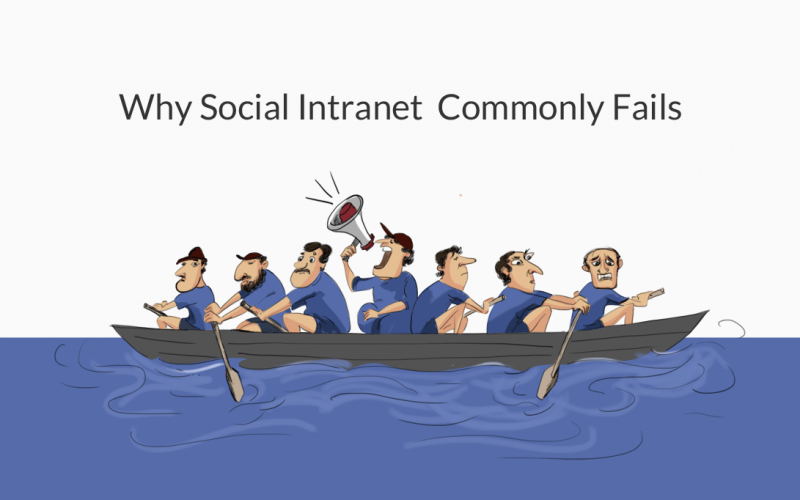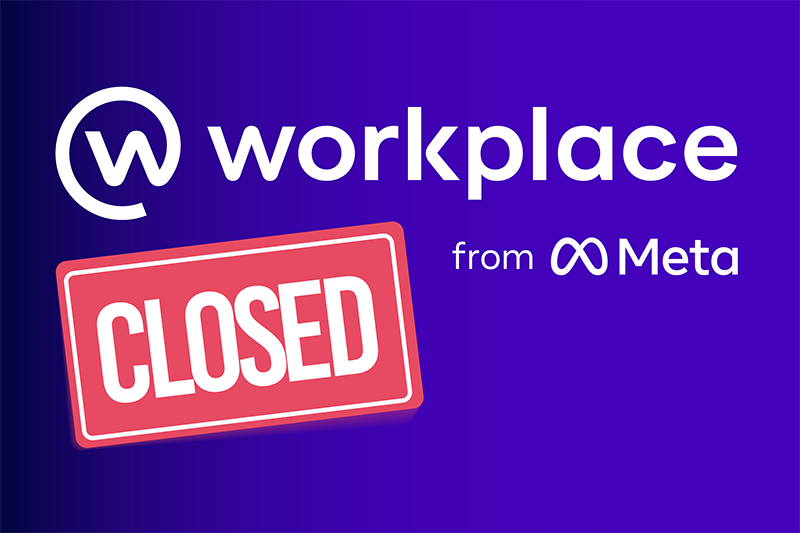- Brahim Jaouane
- October 21, 2015
Why Do Enterprise Social Networks Fail?
Although public social networks have experienced viral adoption and success, the same does not hold for enterprise social networks (ESNs). The “provide and pray” approach, commonly used by enterprises when introducing a social collaboration tool, does not seem to work. Gartner attributes an abysmal 10% success rate for this approach.

Content
Below are what we believe to be the most common obstacles to successful social collaboration in an enterprise, in decreasing order of importance.
1. Management Support: The Ever Missing Piece
Strong management support is probably the most important factor in the success of ESN adoption. Consequently, the lack of this is one of the most important factors, if not the most important, in the common failure of ESNs. While it seems easy, management support is actually difficult to obtain.
Corporate Democracy Is Not to Everyone’s Liking
Depending on the corporate culture, transparency and participation may not be priorities. After all, giving employees more voice and more space could bother managers and may not fit with the vision they have of their company, or how they want things to be run and done.
Even if it is erroneous to believe that “social” automatically brings horizontal organization and tears down any authority in its path, many managers are very uncomfortable with the idea of feedback from their employees.
Many managers prefer to keep using the “old” way and if it works fine, why thrive for better?
Prejudice Against Public Social Networks
Some managers have difficulty in imagining a social network inside their company. Their mental image is that of a public social network. Hence, they automatically associate an ESN with procrastination, wasting time, gossip and plotting. “Enterprise social networks, you said? Thanks, but no thanks.”
Fake Support
However, the most common attitude that we encounter in practice is a manager’s apparent enthusiasm for an ESN project, followed by a complete lack of practical investment. An executive signs off the project for their teams, believing that management, being management, is, of course, excused from having to participate.
Transform your employee experience
with eXo Platform
with eXo Platform
2. Change Management Forgotten
In practice, human factors in the adoption of social collaboration are ultimately much more important than the choice of tool or its features.
Difficult IT-Business Cooperation
A modernization project, such as the introduction of a social collaboration tool, usually requires a cross-departmental initiative between HR, communication and the IT functions. Each of the functions has its own drivers and motivators, but obviously, the ultimate success of the project is very much dependent on the good cooperation between all driving parties.
Thus, the IT team often focuses on the technical project – security, integration etc. – forgetting the importance of managing change. In the same way, business functions often underestimate the importance of integrating the tool with the other company systems for the tool to be of use.
Insufficient Change Management Investment
Very often, the project owner strongly underestimates the resources necessary to drive the change, such as community management and continuous training of users.
This is the case whichever of the previously mentioned functions drives the change. The “provide and pray” approach is very popular because it does not require any continuous investment and effort, and most project owners think they will be the exception to the rule.
The Role of a Long-term Purpose
More often than not, the project is launched without a clear long-term business purpose being agreed by all the driving parties in the company. Without a clear goal, translated into trackable benchmarks and KPIs, success (or failure) cannot be measured, detected or dealt with early on. Having an expressed and clear purpose is then key for success with social intranets, especially in the later stages of the project.
3. User Onboarding Issues
Our last group of reasons deals with end-user onboarding and factors that can prevent its success.
Product Choice
Naturally, a poor choice of product can render onboarding difficult to users and makes them reluctant to use it. The user interface and user experience are of utmost importance for any user-oriented software, particularly for an ESN. A product that has been designed with intuitiveness and familiarity can significantly ease user adoption and reduce training costs.
Dissociation from Business Processes
A collaboration tool must be integrated well with business processes to bring value to the user’s workday. If the tool is apart and outside of what the person’s tasks and pain points are, it will stay unused.
Lack of Technical Integration with Business Applications and Company Environment
A social collaboration tool must be integrated well with the company’s information system and existing business applications for it to bring collaborative value. A social network that stays outside of the business tools that an employee uses in their daily tasks will remain unused. Indeed, collaboration happens when people work together and it is a means to an end for a job well done, not an end in itself.
It is difficult to pinpoint exactly the right amount of technical integration. Integration with Enterprise directory and a document management system appear to be a must-have, in our experience. However, depending on the industry, integration with business applications is also important, if the application is highly used in the company.
Lack of Training
Like the consumer space, an ESN should feel natural to its users, but it won’t. A large proportion of the end users do not use public social networks in their personal lives. For those who do use them, they know how to pass time and have fun connecting with friends, not how to work. As a result, all users need training, just like any other software tool.
Lack of Guidelines
An absence of clear minimal guidelines on how the ESN is to be used in the company context might prevent some users from being active in the network.
“Can I invite somebody I do not know in person to connect with me? Would it be appropriate to comment on this executive post? Can I launch that topic? Is this just for work or can I use it to invite the team for coffee?”
These are common questions we hear from users. If no answers are available, the default option is not to participate.
Profusion of Collaboration Tools
A very common issue for modern enterprises is that there are too many collaboration tools. Not only do companies often have a classical intranet and some type of document management system at the corporate level, but potentially different collaboration and project management tools are used by different teams and departments, and don’t forget the business applications with a collaborative feature.
Ideally, an integrated social collaboration platform will add collaborative power to some of the tools, replace others and ultimately unify all the tools in a natural way for the user. Unfortunately, most of the time, instead of acting as a glue, an ESN becomes yet another tool in a long list of costly and ineffective tools that live in parallel to each other.
Social collaboration is a powerful tool. When introduced successfully, it increases productivity and employee satisfaction, while rationalizing the IT environment and saving costs. We hope our list of obstacles will be a helpful checklist for those who undertake such a social collaboration initiative in their organizations.

FREE WHITE PAPER
Digitization of
Human Resources
Digitization of Human Resources is a hot topic these days. What do companies expect out of it?

Julian dubois
Je suis expert solution chez eXo Platform.
Mon rôle est d’accompagner les clients dans le déploiement de leur projet de plateforme et l’accompagnement au changement lié à ce projet. J’ai piloté et administré une Digital Workplace pendant 3 ans avant de rejoindre eXo Platform.
Améliorer l’environnement et les conditions de travail m’a toujours passioné, je peux maintenant accompagner nos clients dans cette démarche.
Related posts
- All
- eXo
- Digital workplace
- Employee engagement
- Open source
- Future of work
- Internal communication
- Collaboration
- News
- intranet
- workplace
- Knowledge management
- Employee experience
- Employee productivity
- onboarding
- Employee recognition
- Change management
- Cartoon
- Digital transformation
- Infographic
- Remote work
- Industry trends
- Product News
- Thought leadership
- Tips & Tricks
- Tutorial
- Uncategorized
Laisser une réponse
( Votre adresse email ne sera pas publiée)
Connexion
0 Comments
Commentaires en ligne
Afficher tous les commentaires


